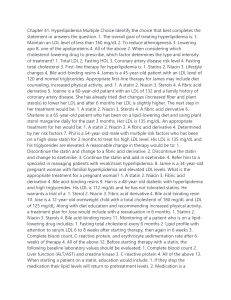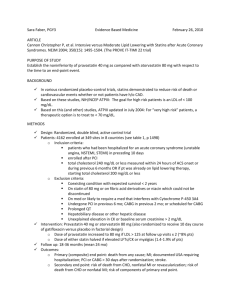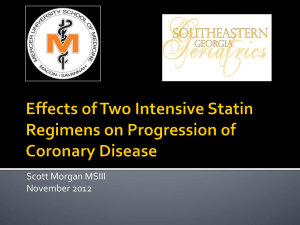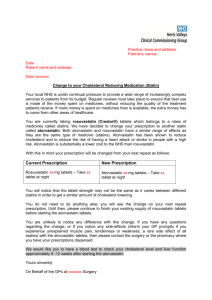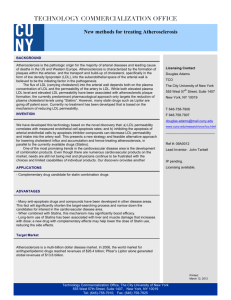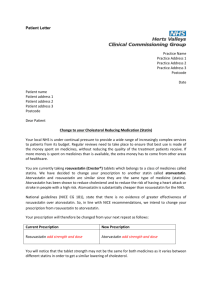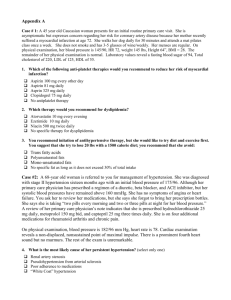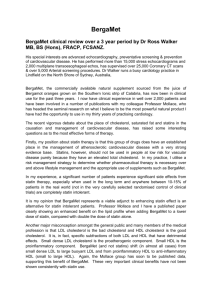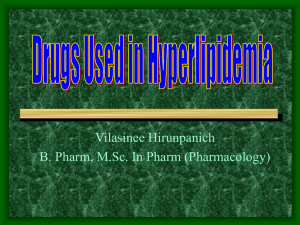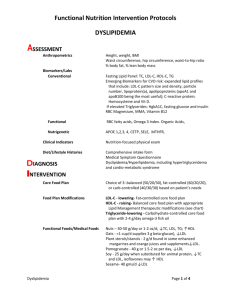Common Questions in Lipids 2010
advertisement
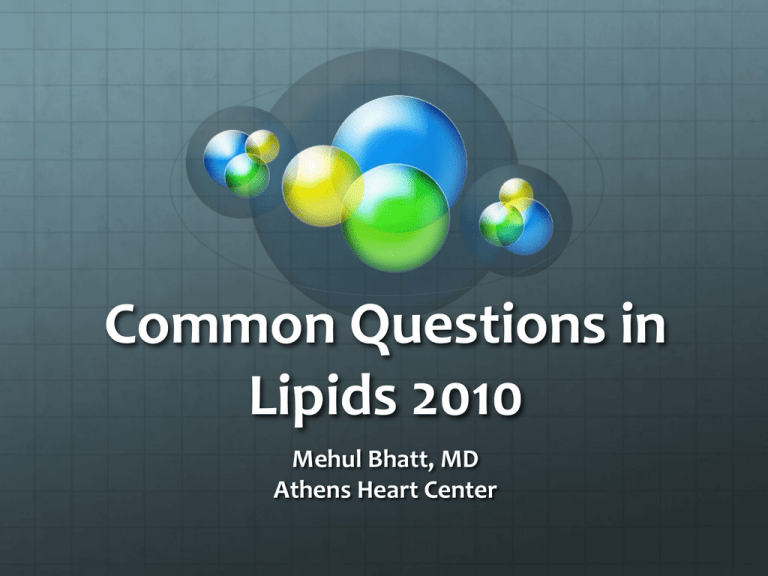
Common Questions in Lipids 2010 Mehul Bhatt, MD Athens Heart Center Contemporary Guidelines (simple enough) National Cholesterol Education Program (NCEP) 2004 LDL < 70-100 mg/dL for CAD and CAD-equivalent risk factors < 100-130 mg/dL for 2+ CAD risk factors < 160 mg/dL for 0-1 CAD risk factor HDL > 40 mg/dL Triglycerides < 200 mg/dL Contemporary Guidelines (simple enough) First: treat LDL . . . Second: HDL > 40 . . . Third: Triglyceride < 200 But…what are common lipid questions in 2010? NCEP guidelines lag behind contemporary lipidology Common issues: Best statin Coenzyme Q-10 Niacin Ezetimibe Nutritional supplements What is the best statin? 6 statins available 3 name-brand: atorvastatin (Lipitor™), fluvastatin (Lescol™), rosuvastatin (Crestor™) 3 generic: lovastatin (Mevacor™), pravastatin (Pravachol™), simvastatin (Zocor™) Efficacy of statins in reducing LDL and CV events undisputed Few head-to-head statin trials What is the best statin? Potency Reduction in LDL at lower dose Achieve goal LDL < 70100 Linear decreasing LDL at higher dosages Rosuvastatin> Atorvastatin, Simvastatin> Fluvastatin, Lovastatin, Pravastatin From Cannon et al. NEJM 2001 What is the best statin? Best data in prevention of clinical events: Pravastatin Simvastatin Atorvastatin Superior to low dose pravastatin MIRACL, PROVE-IT: improved clinical outcomes in the highest risk patients (during acute coronary syndromes) Rosuvastatin JUPITER: improved clinical outcome in low-risk patients with elevated CRP What is the best statin? Prevention of cardiovascular events: JUPITER: Rosuvastatin prevents cardiovascular events in low risk patients PROVE-IT TIMI 22: Atovastatin superior to pravastatin after acute coronary syndromes From Cannon et al. NEJM 2001 and Ridker et al. NEJM 2008 What is the best statin? Atherosclerotic plaque stabilization/regression: REVERSAL Trial 2004 (atorvastatin) ASTERIOD Trial 2006 (rosuvastatin) From Nissen et al. JAMA 2004 What is the best statin? Pleotropic effects Anti-inflammatory effects in atherosclerotic plaque Anti-thrombotic Improve endothelial function Increasing nitric oxide (vasodilator) Inhibits endothelin-1 (vasoconstrictor) Most data with high-dose atorvastatin and rosuvastatin Perhaps mediated through CRP and/or sCD40 What is the best statin? Pleotropic effects: High-dose atorvastatin and rosuvastatin have most proven effect on CRP in large trials From Ridker et al. NEJM 2005 What is the best statin? Summary: Benefits of statins undisputed More benefits in higher risk patients Acute coronary syndromes, high-CRP, multiple risk factors. . . Atorvastatin and Rosuvastatin: Most recent large trials Atherosclerotic plaque stabilization/regression data Are they better than less expensive alternatives? Or do they have more recent data? Does Coenzyme-Q10 work? CoQ10 = Ubiquinone CoQ10: Fat-soluble compound found in hydrophobic portion of mitochondrial membrane Approx. 10% rate of statin related myalgia Statins reduce Co-Q10 levels 25-40% Depletion of skeletal muscle mitochondrial CoQ10 may lead to myalgia and myopathy From Marcoff et al. JACC 2007 Does Coenzyme-Q10 work? Co-Q10 supplementation increases plasma level in patient taking statins Multiple observational and anecdotal reports of improvement in myalgia with Co-Q10 2 small randomized trials in patients with history of myalgia did show benefit Overall, Co-Q10 harmless, inexpensive, and may reduce statin-related myalgia Niacin, revisited… Niacin used clinically in heart disease for over 50 years (pre-statin era) 1st randomized controlled trial in lipids in CAD: Coronary Drug Project: Clofibrate and niacin in coronary heart disease. JAMA 1975; 8,341 males from 31-64 years old with history of MI Randomized to conjugated estrogens, clofibrate, dextrothyroxine, niacin (3000 mg/day), or placebo Niacin had early reduction in rates of MI and a mortality benefit that was maintained at 15-year follow-up! From JAMA 1975 and Canner et al. JACC 1986 Niacin, revisited… Niacin = Nicotinic acid = Vitamin B3 In high doses decreases LDL, increases HDL Most common side effects are flushing, itching, rash Over-the-counter; relatively inexpensive Niacin extended-release tablets: available since 1997 (Niaspan) does reduce flushing rates NSAIDs 30 min before niacin and extended-release niacin are shown to reduce flushing Niacin, revisited… ARBITER 6-HALTS CAD patients with LDL < 100, HDL < 50-55 statin + extended-release niacin (2000 mg/day) - versus statin + ezetimibe Lower LDL with ezetimibe Higher HDL and lower TG with niacin BUT OUTCOMES. . . From Taylor et al. NEJM 2009 Is there any value to ezetimibe? Ezetimibe (Zetia) Decreases intestinal absorption of cholesterol Effective in reducing LDL But, does not reduce plaque or clinical event Probably only useful when statins not toleratated Nutritional supplement therapy SUPPLEMENT EFFECT Red yeast rice, Plantphytosterols and phytostanols (vegetable oil, nuts, legumes, whole grains) Reduce LDL Omega 3 fatty acids (fish oils, certain plants/nuts) Reduce TG, possibly raise HDL, possibly reduce CV event rates Green tea catechins and black tea theaflavins Possibly lower LDL Guggulipids, policosanol, cinnamon, garlic No effect Summary Treat CAD and CAD-equivalent patients to LDL goal < 70-100 “Best statin”: atorvastatin and rosuvastatin have most recent data with pleotrophic effects and plaque stabilization/regression Niacin has important role in lipid management Some quality nutritional supplement have value www.athensheartcenter.com
